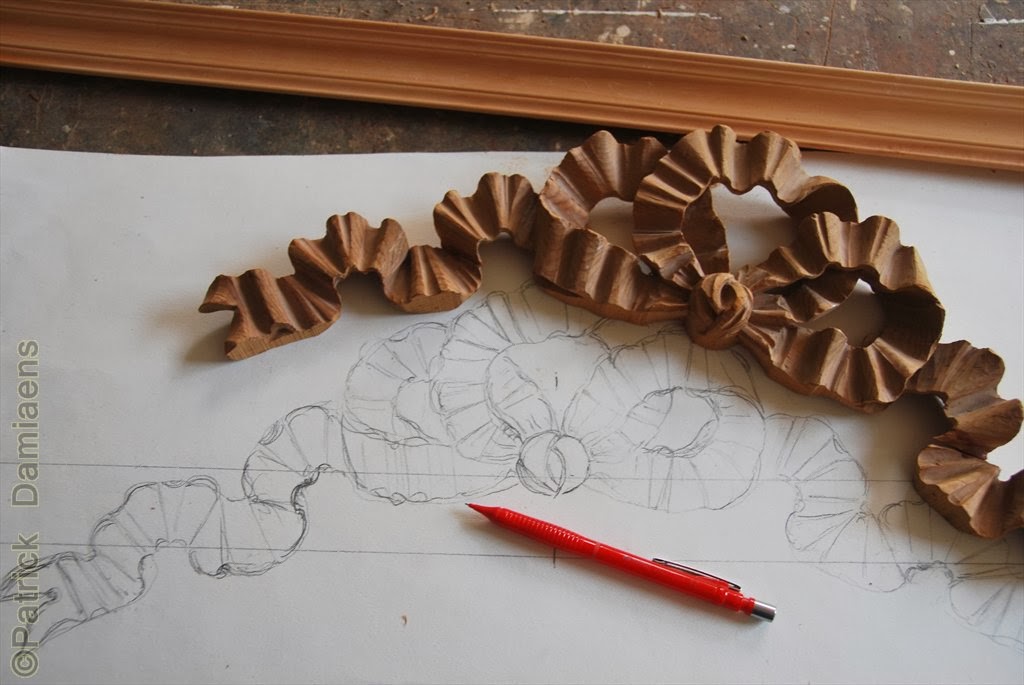The 'Ribbon & Bow' as an ornament
__________________________
Starting from the mid 18th century ornamental ribben and bows often appear in compositions or as a free standing ornament. Ribbon & bows were often used in the “Transition” and “Louis XVI” style periods, and this association therefore represents a clear reference to these particular periods. Ornamental ribbon & bows were commonly applied to painting and mirror frames.
Near the end of the 18th
century an art movement emerged which incorporated many “classical elements”.
This style period is known as Neoclassicism. Neoclassicism was symptomatic of a
desire to return to the “purity” of the arts of ancient Greece and Rome; with a
particular focus on Greco Roman architecture.
During that time the interest in the use of the ornamental bow was rekindled. Consequently, bows carved in wood appear as independent, free standing ornaments or as part of mirror or painting frames; but also as crests on larger frames or simply as a detail in elaborate wood carving.
The application of a ribbon and bow on furniture is almost always combined with other ornaments.
During that time the interest in the use of the ornamental bow was rekindled. Consequently, bows carved in wood appear as independent, free standing ornaments or as part of mirror or painting frames; but also as crests on larger frames or simply as a detail in elaborate wood carving.
The application of a ribbon and bow on furniture is almost always combined with other ornaments.
The ribbon and bow were
commonly combined with several other objects, usually hanging vertically from
the ribbon or bow. This particular composition is referred to as “trophy”. Combined
these objects could represent a wide variety of themes and topics, such as war,
hunting or music. Smaller compositions of fruit or vegetables combined with a
bow are tasteful examples of adornments for all kinds of furniture and
architectural woodwork.
Carving a ribbon & bow in wood
Carving a ribbon & bow in wood
________________________________________________
Several weeks ago I was
asked to carve a neoclassical ribbon & bow in basswood. The client was a small artisanal
company located in the German Ruhr area, that was specialized in the
traditional production of frames and in the gilding of art objects. One of
their customers was in the possession of a slightly damaged ribbon & bow that used to be
part of an oval shaped frame.
This renowned German company
was asked to make a similar style frame as the oval one, but this time the
frame had to be rectangular, adorned with an identical ribbon & bow. It was my task to
carve a 40 cm long ribbon & bow in basswood.
To give an impression of the
dimensions. I started out with a plank measuring 40 x 20 x 3.5 cm. The material
had to be quite thick for visual reasons, as the bow had to “rest” on the top
of the frame. It was also important to keep in mind that the profile of the
frame had to run under the bow.
In a later stage the carved ribbon & bow was to be gilded using gold leaf.
In a later stage the carved ribbon & bow was to be gilded using gold leaf.
_________________________
_____________
Given below is an impression
of the several stages involved in carving a wooden bow
The final result of carver and gilder
(Gilding we discuss in a later blog entry.)
 |
| The design is transferred on the wood |
 |
| The ribbon & bow is sawed out |
 |
| Modeling can begin |
 |
| The original ribbon and bow serves as inspiration |
 |
| Detaching the Ribbon & Bow |
 |
| At the rear the excess wood is cut away |
 |
A carved ribbon & bow for a frame
|
The final result of carver and gilder
(Gilding we discuss in a later blog entry.)
 |
| https://www.patrickdamiaens.info |







No comments:
Post a Comment